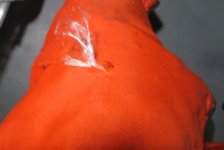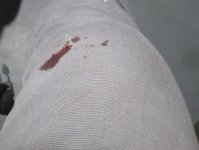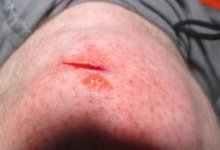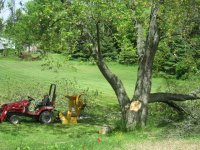Answers to some questions posed here: Washing chaps can make them less effective, (it's detailed in the owner's literature that comes with most brands of chaps), because the safety is in the fibers in the chaps getting caught up in the chain's teeth, and thus stopping the 88 feet /second travel speed of the chain* from doing damage like the op experienced. When washed the fibers tend to mat down vs. being fluffier and the result is less effectiveness. Same with if they get real dirty or greasy/oily.
I noted a number of people in this thread said their accidents or close calls with chainsaw chains occurred when they were tired or too tired.
This is worth paying very close attention to. Using a chain brake when starting, changing location, or position, etc. is a very good, 'best practice' detail that can help prevent serious injuries from chainsaws.
Also, taking frequent breaks in one's work to cool off, drink water to keep hydrated. etc. can keep one's 'situational awareness' at a maximum.
I also try to never work alone with a chainsaw, even for a 'few quick cuts'.
Think about how a chainsaw functions. It is designed to make mincemeat out of wood at a very rapid pace. It turns wood into saw chips instantaneously and thus treats skin and bone the exact same way. It does not discern the difference between wood and flesh.
Because of the type of spacing of chain teeth they cut skin by ripping it to pieces which means that one's chances of bleeding out before making it to the ER are also increased, and that doesn't even take into account the shock factor.
As the OP said, he didn't even know he had cut his knee until he saw the blood.
So, knowing everything one can about how one's saw and it's chain function, knowing best practice handling of the saw, wearing ALL recommended safety gear WHENEVER using a saw, all reduce the likelihood of a catastrophic incident.
Technically, the chainsaw chain should come to a rapid halt on it's own within a few seconds of the trigger being released. If it does not, or continues to run around the bar, then the saw is out of adjustment and needs to be serviced before further use.
One way to stop the chain even faster, aside from applying the chain brake, is to purposefully touch the bar/chain to a piece of wood within easy reach of the saw, using all the necessary precautions against kickback/rollback, etc.
Here's the facts Jack:
From Google inquiry as to speed of a chainsaw's chain~
"The piston ring speed on the average chainsaw travels 2,500 surface feet per minute. A chain slides across the surface of the sawbar rail at around 5000 feet per minute. The chain is moving at 55 to 60 m.p.h. or a mile per minute ( 88 feet per second* ).
One last thing; anyone considering the cost of chaps should seriously consider the cost of a visit to the ER to triage their torn knee, leg, calf, etc. Essentially NO comparison, IMHO.
Here's to the OP~ Sorry for your unfortunate loss to your saw's chain. Thankfully it wasn't worse. Get well soon and be safe in future.:thumbsup:




